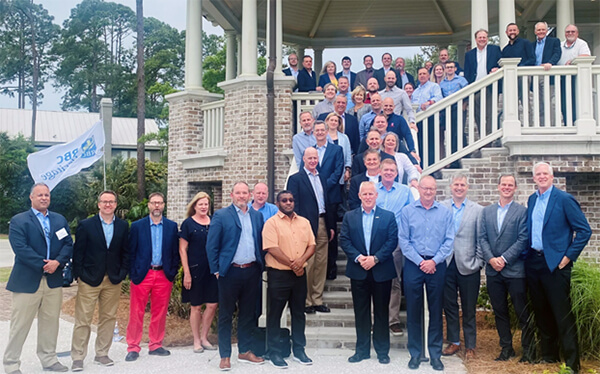How to Spot and Nurture Great Leaders
Ask any leader, and they will tell you that the path to the C-suite is not paved alone. It takes a village of support and litany of resources to develop and nourish high-quality leadership skills. While the qualifications of leaders can vary depending on industry and organization, there are several shared traits that great leaders possess within our portfolio companies.
"Leaders do not live in silos – they are a critical part of the larger community they helm."
Ownership Mentality
By demonstrating a willingness to own their mistakes, leaders can inspire confidence among employees. Staying self-aware, authentic and humble creates a sense of approach-ability that builds meaningful relationships and a culture of trust and empowerment. The determination of leaders who take calculated risks, own their failures, and use them to learn and improve can energize a team to be more proactive and productive. As part of our commitment to leadership development, Argosy portfolio company CEOs, along with our Operating Partners, met this year in Hilton Head, South Carolina for the annual Argosy CEO Summit. At the event, we had the privilege of listening to two four-star Generals share their experiences about what makes a great leader. General James F. Amos, former Commandant of the Marine Corps, emphasized the importance of intent, effectively communicating to teams WHAT needs to be done and WHY it is important, instead of HOW something should be done. General Robert B. Abrams talked about utilizing after-action discussions and root cause analysis to understand what went well and what areas need improvement. He stressed the need for leaders to wear “rhino skin” and be able to give and receive criticism constructively.
People-Centric Culture
Having an entrepreneurial spirit will serve leaders well as they embark on building or rebuilding a company. Leaders should be ready to roll up their sleeves and wear lots of hats, especially in lower-middle market private-equity backed companies. Being resourceful and accessible means being ready to get involved in activities at any level of an organization.
Leadership in service prioritizes the greater good of the company through a people-first approach. At the CEO Summit, both generals agreed that employees in this type of environment are more likely to feel like their voices are heard. General Abrams said that leaders who use terms like “we” and “us” and make themselves accessible to all ranks of the company – not just during formal meetings but for everyday events like lunches and roundtables – are more in tune with the everyday workings of their people. As a result, teams that operate in a people-centric environment “act like owners:” – they feel a greater sense of responsibility and have a bigger stake in the outcome of their work and the success of their organization.
Urgency & Execution
Leaders are tasked with big goals and are expected to deliver. It is important to bring a sense of urgency to the table. Optimizing speed to value often means making the hard calls. Being direct and decisive is not always easy, but it is essential.
Similarly, having bias for action involves feeling confident enough to step out of your comfort zone and leading others to do the same. Rapid innovation and value creation take grit and resolution. General Amos noted that great leaders thrive in chaos – they have the will to push through adversity and the assuredness that they will succeed. This type of urgency and execution is how effective leaders are able to achieve their goals and transform organizations.
Expertise & Immersion
A strong intellectual grasp of the industry at large and the organization in detail is essential to be successful. Effective leaders know their business and industry inside and out. C-suite executives need to be comfortable with a horizontal, non-hierarchical structure and immerse themselves in all levels of the organization to maintain granular insight and an instinctual understanding of essential elements like financial metrics and supply chain operations.
The Argosy Approach to Developing Great Leaders
Argosy has been nurturing talent to successfully lead our portfolio companies for over three decades. We take the time to learn what makes our CEO’s tick with best-in-class assessment tools and in-depth interviews that help us understand their strengths and areas of improvement. Through time-tested programs and resources, we provide the opportunities leaders need to hone their innate qualities and fortify the practical skills it takes to be successful.
What sets us apart is our commitment to fostering a collaborative learning environment among our portfolio company executives. In addition to our annual CEO Summit, we host CEO Roundtable Groups and Functional Summits for portfolio company executives on topics like human capital and sales & marketing. We offer content-rich webinars and lunch and learns to educate leaders and promote a culture of continuous learning. To foster peer-to-peer collaboration, we sponsor cross-portfolio gatherings and have dedicated email rooms where leaders in the C-suite, Sales & Marketing, Human Resources and Operations can ask questions and share ideas with their counterparts. This type of communication and collaboration is a hallmark of great leadership and a priority here at Argosy.
In keeping with our collaboration mindset, our strong Operating Partner Program is a catalyst for leaders who want to learn more. Leaders receive expert guidance from experienced Operating Partners to develop a plan to spur growth and align their organization around an established vision, culture, and priorities. They pair this wisdom and advice with Argosy’s Value Acceleration Methodology, or VAM™, our proprietary business system for growing lower-middle-market-businesses across a wide range of industries. Argosy’s Operating Partners have a partnership mentality and strive to make our senior management teams better.
Focusing on operational improvement, professionalization and revenue drivers, the VAM™ business system helps management teams institutionalize best practices, accelerate growth, and improve business quality and costs. We continuously expand our VAM™ system to give leaders access to a comprehensive library of resources for value creation and business growth. Strategic planning, voice of customer and strategy deployment are cornerstones of the methodology. Recently, we added tools to help leaders implement successful Environmental, Social and Governance (ESG) programs.
To ensure our leaders are prepared for the future, Argosy fosters an environment of continuous learning. The advent of Artificial Intelligence (AI) and the velocity of the global economy means that staying on top of the latest trends, practices and topics is not just a “nice to have,” it is an essential skill of an effective leader of lower-middle market companies.
Business Partner Takeaway
In the dynamic world of private equity, the success of portfolio companies largely hinges on the quality of their leadership. CEOs play a critical role in steering companies toward growth and profitability. The mindsets and practices of the best leaders are focused on ownership and collaboration. A people-centric culture, industry expertise and a willingness and urgency to act are all hallmarks of leadership that help drive value and growth for small businesses.
Argosy Private Equity has the experience and resources to identify and cultivate leaders to reach their greatest potential. Contact Argosy Private Equity to learn how our approach to leadership development can drive value for your organization.







